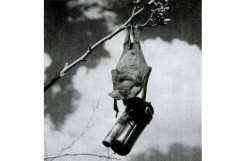Bats with bombs
/I just finished reading Bill Bryson’s At Home: A Short Histroy of Private Life.

I love everything that Bryson writes, and this was no exception. Bryson is one of the very few authors whose work I am willing to read again and again. Each reading is like a brand new adventure.
The funniest part of this latest book is Bryson’s supposed thesis:
He claims to be writing about the history of private life through the framework of a tour his English home. Chapters are named after each room, and the room itself provides the source material for the chapter. But time after time I found myself engaged in stories about anything but private life and quaint English homes. Stories that couldn’t be less about private life.
Don’t get me wrong. I’m not complaining. Bryson could publish a book entitled Random Musings and Utterly Unconnected Stories in an Inconceivable Order and I would buy it and most assuredly love it.
Bryson is that good. And this is what his latest book nearly amounts to.
Case in point:
Bryson writes about bat bombs, the World War II program designed to strap incendiary bombs to bats and send them into Japan cities, where the bats would roost amongst the predominately wooden structures before detonating.
Yes, you read that write. Bat bombs.
Bomb-toting bats.
In a book about private life inside the home, no less.
It was envisioned that ten B-24 bombers flying from Alaska, each carrying a hundred shells packed with bomb-carrying bats could release 1,040,000 bat bombs over the target—the industrial cities of Osaka Bay.
A series of tests to answer various operational questions were conducted. In one incident the Auxiliary Army Air Base in Carlsbad, New Mexico, was set on fire when armed bats were accidentally released. The bats incinerated the test range and roosted under a fuel tank.
My question: How do you strap bombs onto the backs of one million bats?
How many people does an operation like that require, and how long would a process like that take?
The logistics of the operation are mind-boggling.
Unfortunately, Bryson does not address this question in his otherwise thoroughly enjoyable and completely satisfying book.
